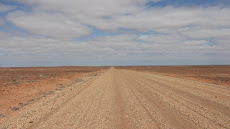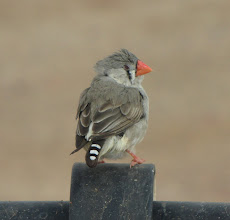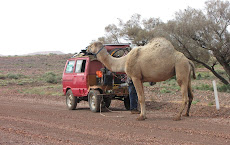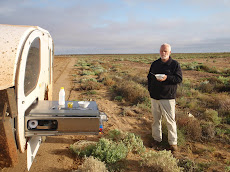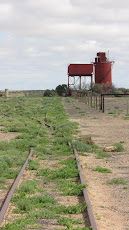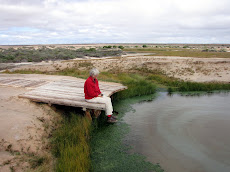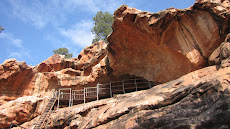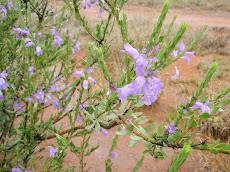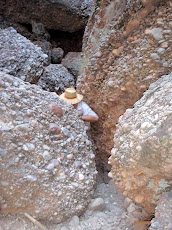 Re-capping from home now, and as always memories lose their edge and soften with time, but we had an interesting journey home from Alice. Wet weather had set in and our brief time with Jane and friend Hollis was spent chasing birdsong in slippery conditions. Hollis is a musicologist who uses particularly Butcher bird song as a starting point for her compositions. She has played at Carnegie Hall and other such places so takes the recording part very seriously. Along with birdsong she plays wire fences with her bow, and was tempted by one or two of the old cattle yard fences round about. An interesting pair are Hollis and Jane! Sadly we had to leave them as they settled in for the night along a remote riverbed, hoping for sunshine in the morning, and a grand early morning chorus.
Re-capping from home now, and as always memories lose their edge and soften with time, but we had an interesting journey home from Alice. Wet weather had set in and our brief time with Jane and friend Hollis was spent chasing birdsong in slippery conditions. Hollis is a musicologist who uses particularly Butcher bird song as a starting point for her compositions. She has played at Carnegie Hall and other such places so takes the recording part very seriously. Along with birdsong she plays wire fences with her bow, and was tempted by one or two of the old cattle yard fences round about. An interesting pair are Hollis and Jane! Sadly we had to leave them as they settled in for the night along a remote riverbed, hoping for sunshine in the morning, and a grand early morning chorus. We said good bye to the “G’day mate” caravan park, a cheerful establishment to which we will return, and made an early start down the road towards Marla, where you turn off onto the Oodnadatta Track, rumoured to be closed. The roadhouse at Marla had local artwork on display and we bought a third piece for Andy at a remarkably good price we thought. A squadron of mud covered cars and vans queued up for fuel so we bent their ears to find out what conditions were like. They had been holed up at Oodnadatta for four days along with dozens of others, due to the track being closed. They had exhausted all that the “village” had to offer within 24hours and had been stir crazy to get out. When these tracks are closed though, they mean what they say. Anyone caught wilfully breaking the closure is rigorously fined on the basis of $1000 a wheel. The tracks are mostly clay based and after 5mm of rain you are sliding about; 10mm has you digging deep ruts and destroying the road surface, making it undrivable when it does dry out because the tall ridges so made are as hard as concrete. The word was that the track was still closed between Oodnadatta and William Creek, so we embarked on a zig zag course tacking upwind, Marla-Oodnadatta, Oodnadatta-CooberPedy, Coober Pedy-William Creek. Yes, a long way when you could just drive south down the Stuart Highway and do half the distance and mostly on bitumen. This back-of-beyond mentality has its costs, but it’s like a good social drug.
We said good bye to the “G’day mate” caravan park, a cheerful establishment to which we will return, and made an early start down the road towards Marla, where you turn off onto the Oodnadatta Track, rumoured to be closed. The roadhouse at Marla had local artwork on display and we bought a third piece for Andy at a remarkably good price we thought. A squadron of mud covered cars and vans queued up for fuel so we bent their ears to find out what conditions were like. They had been holed up at Oodnadatta for four days along with dozens of others, due to the track being closed. They had exhausted all that the “village” had to offer within 24hours and had been stir crazy to get out. When these tracks are closed though, they mean what they say. Anyone caught wilfully breaking the closure is rigorously fined on the basis of $1000 a wheel. The tracks are mostly clay based and after 5mm of rain you are sliding about; 10mm has you digging deep ruts and destroying the road surface, making it undrivable when it does dry out because the tall ridges so made are as hard as concrete. The word was that the track was still closed between Oodnadatta and William Creek, so we embarked on a zig zag course tacking upwind, Marla-Oodnadatta, Oodnadatta-CooberPedy, Coober Pedy-William Creek. Yes, a long way when you could just drive south down the Stuart Highway and do half the distance and mostly on bitumen. This back-of-beyond mentality has its costs, but it’s like a good social drug.  After a night beside the track we renewed acquaintance with the Pink Roadhouse in Oodnadatta, up for sale since early in the year – as its remarkable owner Lynnie Plate said: ”no-one is as crazy as we were all those years ago”. Shortly afterwards we stopped for a chat with traveller Klaus who spends his life walking beside his camels towing a cut-off Hilux van - he would be in Cooper Pedy in 10 days, us in a couple of hours. He was very happy to be given a pair of Ian’s runners. (Google Klaus and camel!)
After a night beside the track we renewed acquaintance with the Pink Roadhouse in Oodnadatta, up for sale since early in the year – as its remarkable owner Lynnie Plate said: ”no-one is as crazy as we were all those years ago”. Shortly afterwards we stopped for a chat with traveller Klaus who spends his life walking beside his camels towing a cut-off Hilux van - he would be in Cooper Pedy in 10 days, us in a couple of hours. He was very happy to be given a pair of Ian’s runners. (Google Klaus and camel!)As we left Coober Pedy at 16:30hrs we knew we would be driving on dirt for at least an hour or so in the dark, something we have avoided in about 50,000kms of outback driving. Sure enough spots of rain began to fall as dusk enclosed us, with at least 100kms still to run into William Creek. The road though was beautiful and smooth, obviously none of the rain had fallen over this country for a while. I said to Helen “this is too good, I’ll bet something crops up before we get there”, and sure enough it did! Pitch dark and a car pushing behind us 200 metres back, A gentle bend in the road with a track off to the left that had my attention. Deep muddy ruts developed out of nowhere and then standing water. Just not enough time to observe it properly before we were committed. The safe track wound off to the right through trees but we were in to it already. I had cleaned the car and van in Alice knowing it was a foolish enterprise, but you feel better with a clean rig. Well, not any more as we emerged well coated from top to bottom. The glimmer of a few lights that is William Creek by night was very calming and it took no time at all to decide to prop up the bar for an hour by way of recovery. Small world. The proprietor behind the bar was wearing an apron with “Redesdale Camp Oven Cook Off” emblazoned across the front of it. Her last pub was one of our locals!
The bit was firmly clenched between the teeth now, and even Helen agreed we should press on with much haste. An early start next morning and we reached William Creek proper about a quarter of an hour out of the hamlet. We had been warned that this was the only real watery obstacle on the southward run down the Oodnadatta Track. Five minutes of careful evaluation and mud probing of possible alternatives and we realised there was no alternative but to “go for it”. This was the creek that had snaffled one of the many travellers who were still trapped in William Creek pub. We met him at the phone booth and he introduced himself as “the one who drowned his car and was on the news”. Clearly things had not gone well for a lot of folk during
 the previous rainy spell. So we took this 30 metre wide stretch of deep muddy creek seriously. Much care was called for along with some good entry speed and plenty of revs. The Vista weighs 1100kgs so clear heads were called for.
the previous rainy spell. So we took this 30 metre wide stretch of deep muddy creek seriously. Much care was called for along with some good entry speed and plenty of revs. The Vista weighs 1100kgs so clear heads were called for. When you have made up your mind you get this “just do it” feeling, so we clambered aboard and set off with hearts pumping and adrenalin flowing. Gee it seemed deep and we didn’t have enough speed on before we were dropping deep in. The van felt heavy and I had to turn the steering wheel side to side to keep purchase and to keep moving. Helen shrieked “come on car, come on”, whacking it like a horse. The far side seemed to take forever to come closer but with wheels spinning and mud flying everywhere, hot smells of oil and engine in the cabin, we knew we’d make it. I stopped on the far side and we took stock, winners are grinners, but I knew something was wrong as I looked down and realized the hand brake was still on!
You have to laugh don’t you!
The rest of the day was spent revisiting (since our first trip in 2008) the Track’s highlights and Ghan history, eg Strangways Springs with its pastoral and Telegraph station ruins, rail sidings like Curdimurka, artesian mound springs, Lake Eyre South, finally arriving in Maree, home of Tom Kruse the Birdsville mailman. Onwards south beside the Flinders Ranges, and after a magnificent drive in the dusk through the Arkaba Hills we camped at Rawnsley Park
Next morning’s treat just out of Hawker was three art sites in Yourambulla caves with paintings mostly of manganese, charcoal, red or yellow ochre. South Australia’s broad acre grain plains are dotted with the beautiful stone ruins of once smaller farms, like this one near Peterborough.
 Covering the ground smartly through the Riverland irrigation and fruit areas along the Murray, we camped on Saturday night (28 August) in one of the Chowilla camps in mallee conservation areas over the border in NSW. A 5am start next morning put us on a beautiful drive to Wentworth through mallee and desert country with decent roadside remnant vegetation. After paying homage to the junction of the Darling and Murray rivers at Wentworth we headed for breakfast at Stefano’s café in Mildura. This set us up for the less interesting drive down the Calder Highway to reach home by 5pm. What joy to see the place looking gorgeously green, grass trimmed by the ‘roos, and bulbs awaiting our arrival before flowering. Better still, the weeds had been held at bay by the cold, wet winter. Not for long though – we have been waging war on Capeweed and gardening during September and October, a partial excuse for not finishing the blog until today!
Covering the ground smartly through the Riverland irrigation and fruit areas along the Murray, we camped on Saturday night (28 August) in one of the Chowilla camps in mallee conservation areas over the border in NSW. A 5am start next morning put us on a beautiful drive to Wentworth through mallee and desert country with decent roadside remnant vegetation. After paying homage to the junction of the Darling and Murray rivers at Wentworth we headed for breakfast at Stefano’s café in Mildura. This set us up for the less interesting drive down the Calder Highway to reach home by 5pm. What joy to see the place looking gorgeously green, grass trimmed by the ‘roos, and bulbs awaiting our arrival before flowering. Better still, the weeds had been held at bay by the cold, wet winter. Not for long though – we have been waging war on Capeweed and gardening during September and October, a partial excuse for not finishing the blog until today!













































